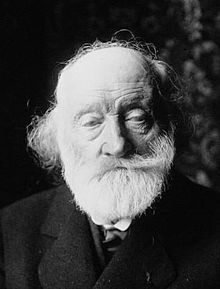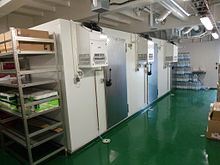Provision refrigeration system on ships
A provision refrigeration system on ships is a refrigeration system consisting of refrigerant compressors , condensers and evaporators , which is used on a ship to cool perishable food for the crew .
History of the provision refrigeration systems
The system of a refrigeration system with compression based on the principle of the cold steam engine was registered for a patent by Jacob Perkins in England in 1834. It contains all essential parts of a cold steam engine and its mode of operation is correctly described. A first version of this refrigeration system worked with ethyl ether as the refrigerant . This principle only gained practical significance through James Harrison in Australia, who put this design into practice from 1850 in order to carry out the ship transport of frozen meat to London. He also used the flammable ethyl ether as a refrigerant.
Charles Tellier in Paris developed this technology further and in 1864 presented his first systems with methyl ether as a refrigerant, which were also used to transport frozen meat by ship. These inventors were not granted lasting success, as the machines were very fragile and leaky and the use of the flammable refrigerants posed huge problems.
In 1875, compressors with methyl ether as a refrigerant were built by the Augsburg-Nuremberg machine works according to better designs by Carl von Linde . This compressor had mercury as a sealing liquid in the cylinders and glycerine for lubrication and sealing to prevent leaks . Since the practical suitability was not proven due to the difficult operation, further improvements were made. These structurally revised compressors and the change in the refrigerant to ammonia resulted in a satisfactory, practical system. From 1877 the first systems were delivered to breweries and soon afterwards they were also used in shipping. About ten years later, the English company Hall introduced cold steam machines with carbon dioxide as a refrigerant, which then became particularly popular in English-speaking countries. This was also the time when shipping specialized and ships were only built to transport oil, refrigerated cargo and passengers. Thanks to the systems for cooling provisions introduced on passenger ships during this period, even well-off passengers were ready to undertake longer journeys by ship.
application
Provision refrigeration systems are used on cargo ships to cool perishable food for the crew. Two to four rooms are provided for this, depending on the size of the ship and the number of crew. The provision rooms are arranged near the galley to avoid long walks .
On ferries with passenger facilities and cruise ships , there can be well over 20 rooms, since drinks, flowers and various fresh vegetables and fruits are also stocked at their specific temperatures. Indirect cooling then often takes place here, i. H. the refrigerant evaporators absorb the heat of evaporation from an intermediate circuit and instead of the evaporator there are so-called air coolers in the rooms. A distinction is made between dry food, frozen food (meat, fish, is usually delivered at the right temperature) and fresh food such as eggs, milk, fruit and vegetables.
The layout is based on the area of travel (ambient conditions) and the duration of the journey, the number of crews and passengers, and international and national regulations such as BUS Public Health Service (USPH), regulations of the classification societies , environmental regulations and, for naval ships, construction regulations of the respective armed forces.
technical description
The cold rooms should ensure optimal storage conditions in terms of temperature and humidity. Ceilings, walls and floors are provided with an insulating layer, the thickness of which depends on the indoor and outdoor conditions. In order to avoid radiation losses, there are no windows and special thermally insulated doors are used. To reduce the loss of cold when entering, vestibules are provided. Food storage rooms must be equipped with waterproof surfaces that are easy to clean. Since the air humidity is generally very high, the entire electrical installation is intended for damp rooms.
On cargo ships, the provision cooling systems are cooled directly according to the principle of cold steam machines, the compressors and condensers are often located in the engine room and the refrigerant evaporators are located in the cold room. As a rule, at least two redundant systems are required. Compression refrigeration systems are mainly installed for on-board applications. The required cooling capacity results from the sum of the losses, which are made up of the transmission heat, fan capacity, lighting, passenger traffic and, depending on the refrigerated goods, through cooling and metabolic heat (only applies to living products with metabolism such as fresh fruit and vegetables). The refrigerant compressors used are open or semi-hermetic piston or screw compressors . In the future, it is to be expected that fully hermetic compressors (scroll or rotary piston compressors) will increasingly be used in order to minimize refrigerant losses. The performance of the compressors is regulated via the suction pressure. The switching on and off of entire compressors and the cylinder deactivation come into question. In large systems on cruise ships, continuous control is carried out by adjusting the speed or the power slider on screw compressors.
The heat of evaporation is withdrawn from the interior air of the cold room; the air speed is increased by fans to improve the heat transfer. The temperature of the individual rooms is usually controlled in two-point mode using a thermostat switch . At evaporation temperatures below 0 ° C, the air cooler or evaporator must be defrosted at regular intervals. Defrosting can take place with the help of electrical defrosting heaters or with hot gas from the refrigeration circuit. In the case of plus cold rooms, defrosting can also take place by simply switching off the cooling (circulating air defrosting).
Refrigerant
As it is advantageous for logistics reasons to only use one refrigerant per ship, the air conditioning and provision cooling system are usually operated with the same refrigerant. A compromise is made between the two areas of application. R404A and R-410A are mainly used as refrigerants on ships today .
See also
literature
- R. Plank: Handbook of refrigeration technology. Springer-Verlag, 1962.
- Pohlmann: Taschenbuch der Kältetechnik. 20th, revised. and exp. Edition. VDE-Verlag , Berlin / Offenbach 2010, ISBN 978-3-8007-3238-8 .
- NN: History of the company for Linde's Eismaschinen, AG, Wiesbaden: 50 years of refrigeration technology; 1879-1929. Wiesbaden 1929, DNB 579454118 .
- K.-H. High-rise: cooling applications on ships. In: HL von Cube et al. (Ed.) Textbook of refrigeration technology. 4th edition. Volume 2, CF Müller Verlag , Heidelberg 1997, ISBN 3-7880-7509-0 , pp. 977-1030.
- K.-H. Hochhaus, Y. Wild: Provision cooling systems. In: Hansheinrich Meier-Peter (Hrsg.): Handbuch Schiffsbetriebstechnik. Seehafen-Verlag, Hamburg 2006, ISBN 3-87743-816-4 , p. 815,






